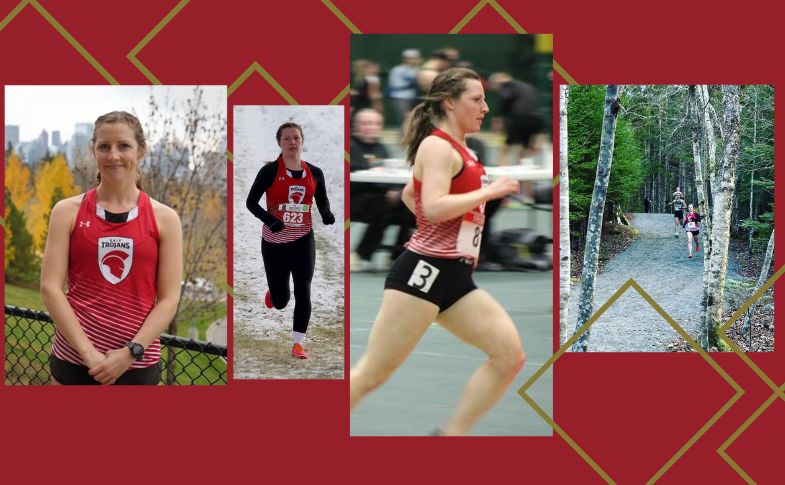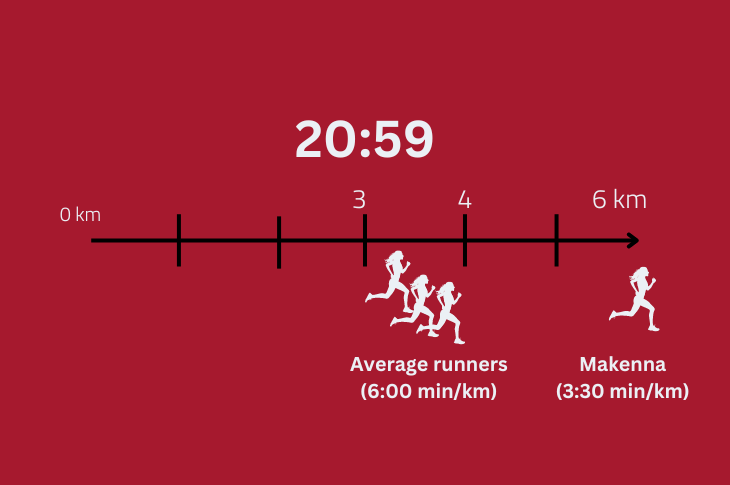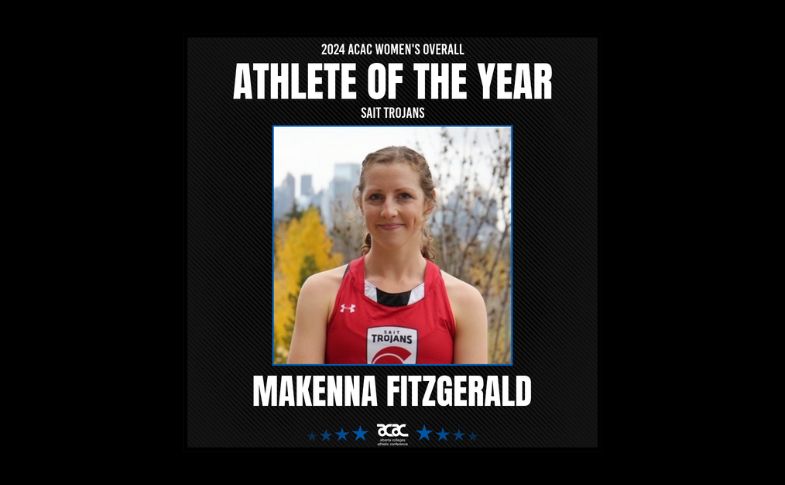Star runner breaks records and finds her footing in healthcare #HereAtSAIT

*Cue viral song Track Star by Mooksi*
She’s a runner, she’s a (cross-country) track star.
Makenna Fitzgerald runs fast.
She’s so quick on her feet she was first to cross the finish line and climb to the top of the Canadian Collegiate Athletic Association (CCAA) Cross-Country Championships podium — not only once or twice, but three years in a row, making history as the only woman to do so.
In her last CCAA championship as a SAIT Trojan, she also unlocked her personal best, finishing the six-kilometer course at 20:59 and beating the Alberta Collegiate Athletic Conference (ACAC) record — which she set about a month prior.
To put that in perspective, an average runner might expect to run that distance around 30 minutes or more.

It’s probably no surprise Makenna was announced the 2023-2024 ACAC Women’s Overall Athlete of the Year, an accolade she also received last year. The results can’t be reduced to just natural talent, because her training routine speaks volumes.
An hour and piece of banana bread a day

Every day, she runs for an hour, often fueled by a piece of banana bread or another treat she baked and tossed in her freezer previously.
Her runs include speed work, slow runs (often with friends — it’s better that way, she’ll say) and tempo runs, which are done at a moderately difficult but sustainable pace. Dedicated sessions in the gym for strength and time devoted to proper rest and recovery are also key components of her athletic regimen.
The work ethic Makenna showcases in her sport is no different than her hard work in the classroom. She’s a recent grad of SAIT’s competitive Diagnostic Medical Sonography program.
The journey to medical imaging
While she was an undergraduate student in biochemistry at Queen’s University, a classmate told Makenna about medical sonography. Medical school hadn’t seemed like the right fit, plus Makenna wanted to be closer to family in Kamloops. SAIT felt like the right choice.
The 26-month Diagnostic Medical Sonography program includes in-class theory, practical application and a year-long practicum. Students can expect to graduate with credentials in ultrasound technology, which is a critical component of modern healthcare diagnostics. They learn the science behind the tech and how to assess and image different parts of the body.
“We’re trained to differentiate between normal and abnormal. Our job is to tell the radiologist, ‘something’s abnormal’,” says Makenna.
“In school, we scanned each other in lab all the time — so we got a really good sense of what normal looks like.”
Practicum is where she found herself in clinics and hospital settings, being exposed to more situations — including blood clots, obstetrics (pregnancy, childbirth and postpartum) and cases of appendicitis.
Makenna has only praise for the SAIT program. “I loved it. All the instructors were really good. You could tell that they wanted us to learn and do well. And it really felt like they wanted us to succeed as much as we did,” she says.
Small classroom sizes gave her a sense of community and were a welcome change to the large lectures she experienced in her undergrad.
“I feel like we all got really close and had a good sense of community which was really nice.”
Road to running
The desire for community is also what led Makenna to competitive running. A hockey player in high school, she found herself longing for the environment of competitive sport. A friend at Queen’s connected her to the university’s cross-country development team, so she traded skates for a pair of running shoes.
“I just wanted to meet people and run,” she says.
Her first half-marathon time was under 1:30, the benchmark to make the competitive team. Unfortunately, a difficult injury when she was 19 put her on crutches and sidelined her. During her recovery from the fracture, she considered her future in road racing and was reminded of the importance of proper fueling to avoid future injury.
In Calgary, she joined the SAIT Trojans cross-country team. Cross-country running provides varied terrain, often in challenging weather, and typically two to three loops totaling six kilometres.
Makenna was the only girl on the team in her first year running at SAIT, which grew to five strong in her final season. SAIT’s cross-country coach, Ryan Edgar, says Makenna set a great example for the team.
“She’s putting in the work to be successful, and if she wants to, she can continue in her career and be a competitor on the national stage.”
Makenna is grateful to Ryan’s coaching and willingness to run with her before a meet, especially when she was the sole female member of the team.
“I really like to run with people during my warmup,” she says. “Because I find it takes a bit of the stress off. If I’m just running by myself ahead of the race, I get pretty worked up.”
What’s next
While she’s crossed the SAIT finish line, Makenna’s journey as a runner and as a medical sonographer is only just beginning.
“I have a passion for both,” she says.
“I see a lot of really sick people at work, so it makes me really grateful that I can run.”
For now, she’d like to see how far road racing can take her, with a few races on the docket for this summer, including a few 10ks and half-marathons. Eventually she’d like to move up to the marathon.
Makenna’s journey as a runner and student proves excellence comes in the shape of discipline, consistency and hard work, and doing the things you love, whether it’s in the pursuit of a career or sport.
Commitment to Excellence
We prepare students for successful careers and lives.
SAIT'S
2020-2025
Strategic plan

Oki, Âba wathtech, Danit'ada, Tawnshi, Hello.
SAIT is located on the traditional territories of the Niitsitapi (Blackfoot) and the people of Treaty 7 which includes the Siksika, the Piikani, the Kainai, the Tsuut’ina and the Îyârhe Nakoda of Bearspaw, Chiniki and Goodstoney.
We are situated in an area the Blackfoot tribes traditionally called Moh’kinsstis, where the Bow River meets the Elbow River. We now call it the city of Calgary, which is also home to the Métis Nation of Alberta.